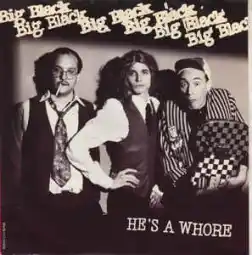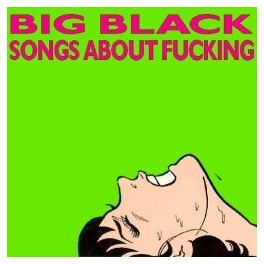I had never seen this record sleeve before. Isn’t it horrible? It’s the mighty Big Black imitating Kraftwerk. Left to right, Steve Albini, Santiago Durango, Dave Riley.
In 1987 Big Black released their cover of The Model as a B-Side to another cover, He’s A Whore by Cheap Trick (they imitated Cheap Trick on the front cover). It was their last single. Both songs also appeared on the CD version of Big Black’s final album, Songs About Fucking, but only The Model made it onto the vinyl release, and that’s where I know this song from.

Big Black were an amazing band – powerful, shocking, thought-provoking and funny. They’d finished by the time I discovered them but I was a big fan before Steve Albini started really making his name by recording The Breeders and Nirvana. I bought Atomizer – the earlier, better album – Millhouse bought Songs About Fucking and we each taped our copy for the other.
As a child, Albini was compelled to move from town to town by his father’s work – Albini senior was apparently a rocket scientist. Skinny, sarcastic and smart-arsed, the young Albini seldom made a good impression at new schools and he had few friends. He credits bands like the Ramones, Stooges, Suicide and Television for getting him through high school. While recovering from a broken leg sustained in a motorcycle accident at the age of 19 he taught himself to play the bass.
On enrolling at college in Chicago in 1980, Albini immersed himself in the city’s active punk scene, becoming a devoted fan of local heroes Naked Raygun and attending their gigs religiously. He began broadcasting on college radio and writing a monthly column entitled Tired of Ugly Fat? for a Chicago fanzine. Through these media he began to gain notoriety for the witty but venomous broadsides he’d aim at characters in the scene – this reputation would only build over the years. Here are some of his words of wisdom:
- Albini on the Pixies – “a band who at their top dollar best are blandly entertaining college rock.”
- Albini on Mudhoney – “it’s silly how great they think they are. It’s almost offensive to me.”
- Albini on Courtney Love – “psycho hose beast.”
- Albini on Al Jourgensen – “I’ll cut your balls off and sew them shut in your mouth.”
His column and radio work split opinion and gave him a profile in the music scene, but what he really wanted was to make his own music. After unsuccessfully attempting to get the sound he wanted with a couple of short-lived groups, self-sufficient Albini bought himself a drum machine and a guitar and borrowed a four-track for a week.

The result of this endeavour would become Big Black’s debut EP Lungs. These days Albini apparently hates the Lungs EP – “It just makes my flesh crawl. I can’t listen to that record anymore” – but it sounds fucking good to me, particularly the opener Steelworker (“I’m a steelworker, I kill what I eat. Great big thing crawling all over me”). It lacks the ferocious power of Big Black’s later output, but it’s fantastically unsettling and possesses a video nasty-era sense of impending violence. It later formed the first side of The Hammer Party album, which you should definitely own.
In 1982, at the point that 1,500 copies of Lungs were released on Ruthless Records, Big Black still consisted of Albini and his drum machine – Roland. The release of Lungs helped Albini to entice guitarist Santiago Durango and bass player Jeff Pezzati of his beloved Naked Raygun to join him and Roland, turning Big Black into an actual band.
The new line-up’s first studio output was the Bulldozer EP, which took the template established in Lungs – exploring dark, sordid themes to an accompaniment of drum machine beats and jagged, unconventional guitar sounds – and turned it up several notches. Cables was about bored kids sneaking into a slaughterhouse to watch the action; Pigeon Kill was about a town-wide pigeon cull utilising poisoned corn, while the opening sample on Seth is an horrific rant from a white supremacist. Overall the sound, the ideas and the riffs on Bulldozer set it apart from its predecessor – Texas is a highlight – and it represents a big leap forward for Big Black. Bulldozer would become the second side of The Hammer Party.
The Racer X EP followed – featuring the excellent Deep Six – but it was after that, when Dave Riley replaced Jeff Pezzati on bass that Big Black really took shape. Riley had previously worked at a recording studio in Detroit that had been frequented by Sly Stone and George Clinton and he brought an element of funk to the group that complemented it, against all logic, and helped to define its later output, the high watermark of which was their 1986 debut album Atomizer.

Atomizer sees Big Black trawling up pulp legends from the darkest depths of small town America and setting them to music that’s sometimes so abrasive it hurts. Bazooka Joe is an upbeat ditty about a desensitised Vietnam veteran putting his numbness to violence to profitable use, Bad Houses is about an individual’s compulsion to do “bad things…even when the thrill is seldom worth the degradation”. Jordan, Minnesota is a deeply unsettling tune about child abuse while Kerosene opens with a guitar riff reminiscent of grotesquely warped church bell chimes and famously references a small town resident who combines his twin loves of sex and arson.
Albini enjoys himself in the sleeve notes, enigmatically describing each little horror story masquerading as a song and crediting the band as “Dave Riley: bass, flyswatters”, Santiago Durango: “train guitar”, Steve Albini: “rocket guitar”, Roland: “Roland”. The combination of macabre subject matter, dark humour, relentlessness and sheer power tapped a vein in underground circles, sparking myriad bad imitations and elevating them to new levels of popularity.

By the time Big Black recorded their next LP, Songs About Fucking in 1987, they’d already announced their intention to split. The stated reason was that they didn’t want to outstay their welcome, but Durango’s decision to start law school may have been a catalyst. Songs About Fucking – its ironic title derived from Albini’s often-stated bemusement at love and romance having become music’s default subject matter – sees Big Black treading similar territory to Atomizer, and it’s another fine album. Kasimir S. Pulaski Day and Bad Penny are among the best things that they ever recorded, but the cover of Kraftwerk’s The Model is the standout track for me. The band take the kitsch euro-pop of the original and explode every aspect of it. Dave Riley turns the bassline into a monster, backed in the rhythm section by the ever hard-thumping Roland. Santiago Durango’s guitar is shrill and piercing, like a dentist’s drill, while the lyrics, in Albini’s distorted voice, suddenly seem threatening – Kraftwerk singing ‘I’d like to take her home with me, it’s understood’ sounds sophisticated and sexually confident; Albini makes it sound downright sinister. Big Black make the song completely theirs and wipe the (blood-stained) floor with the original.
So in 1987, after their final show at The Georgetown Steam Plant in Seattle, Big Black did indeed break up. Dave Riley and Santiago Durango pretty much retired from the music scene there and then, though one of Durango’s first cases as a lawyer saw him helping to recover Cynthia Plaster Caster’s bronze casts of rock star genitalia. Albini of course became a world renowned producer with Nirvana, The Breeders, The Wedding Present and many, many others. He also kept performing, first briefly with Rapeman, and then, to this day, with Shellac. Steve Albini remains a wildly unique musical talent, a punk rock trailblazer and a loud and uncompromising voice on the industry he loves but the work he did with his colleagues in his first band still stands out as his best.
‘Hurdy Gurdy Man’ by Donovan covered by Butthole Surfers – Magnificent Cover Version No.8


9 comments